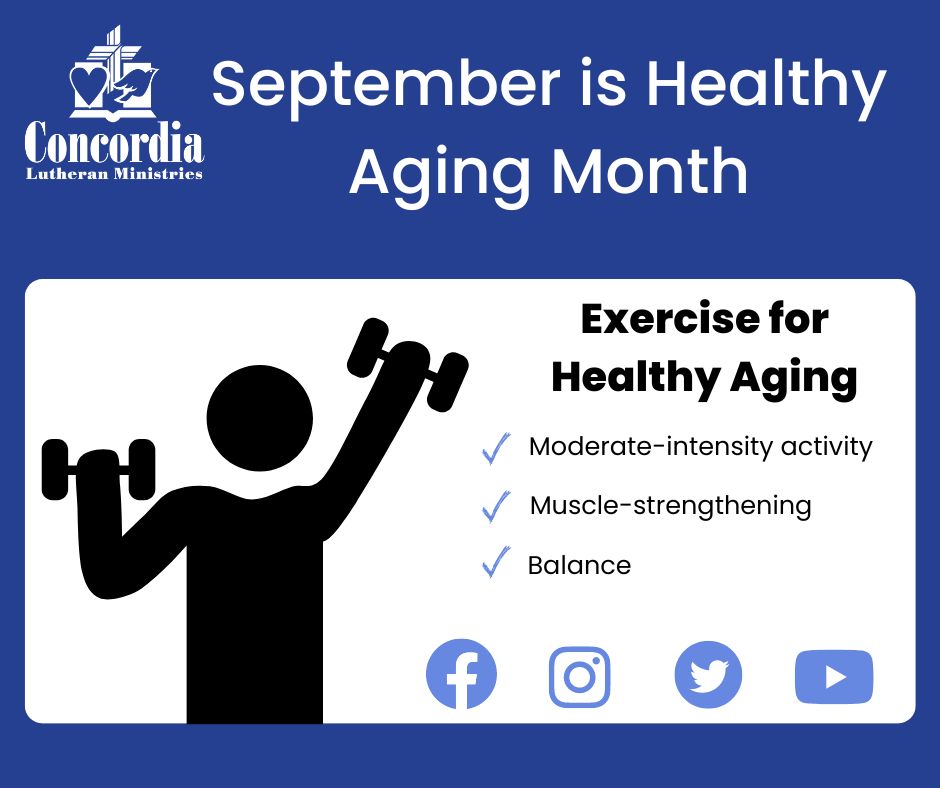Exercise for Healthy Aging

September is Healthy Aging Month, an annual health observance established 30 years ago with the goal to bring national attention to the positive aspects of aging. The month promotes opportunities for older adults to make lifestyle improvements that will boost their physical, mental and social wellbeing.
It’s no secret that regular exercise, a healthy diet and establishing a consistent sleep schedule all help to sustain optimal health at any age. For older adults, adopting a healthy lifestyle
can help lower the risks of certain cancers and chronic diseases, curb obesity, maintain muscle mass, prevent falls and recover from a surgery or illness more quickly. Regular exercise can reduce anxiety, depression and stress while also improving self-esteem, cognitive function and memory.
Related: 6 Key Nutrients for Healthy Aging
According to the CDC, adults aged 65 and over need at least 150 minutes a week of moderate-intensity activity, two days a week of activities that strengthen muscles and up to three days a week of incorporating balance activities such as standing on one foot or walking backwards.
Moderate-intensity physical activities
Moderate-intensity physical activity means you’re working hard enough to break a sweat and raise your heart rate by 50 – 60%. A quick way to check if you have increased your heart rate is by talking – if speaking takes a little more effort than usual and you’re able to do so without gasping for air, you are likely exercising at a moderate intensity. Try mixing intentional exercise and everyday chores to reach your 150 minutes per week goal:
· Brisk walking
· Biking five miles
· Swimming laps
· Dancing
· Walking stairs
· Gardening
· Raking leaves
· Vacuuming
Muscle-strengthening activities
Muscle-strengthening activities helps prevent age-related muscle loss, strengthen bones, promote mobility and lessen fall risk. Slow movements with lighter weights encourage muscle strength. For the best benefit, do each activity to the point where it becomes difficult to do another repetition without help. As you become stronger, you’ll be able to increase the difficulty of your training. Try various activities to work all muscle groups including your legs, hips, back, abdomen, chest, arms and shoulders:
· Carrying groceries
· Using your own body weight, such as push-ups and sit-ups
· Working with resistance bands
· Pilates
· Lifting weights
· Calf raises
· Lunges
· Marching in place
Balance activities
Balance activities help prevent falling. The CDC cites falls as the leading cause of injury-related death for older adults aged 65 and older. Good mobility, strength and being confident on your feet can help you stay independent as you get older. Take your time with balance activities until you have a feel for your comfort level, and be sure to have something nearby to grab onto in the event you lose your balance:
· Walking backward
· Standing on one leg for 20 seconds
· Using a wobble board for 2-3 minutes
· Walking while alternating knee lifts with each step
· Standing up and sitting down from a chair without using your hands
Related: 4 Steps to Healthy and Happy Aging
If you would like more information about our senior care locations in Western Pennsylvania, Eastern Ohio or Tampa, Florida, visit our Locations Map or call our administrative headquarters at 724-352-1571.

Get Updates From Concordia
There is always a LOT happening at Concordia! Would you like to stay up-to-date with our news and events? Sign up for our monthly e-newsletter here.